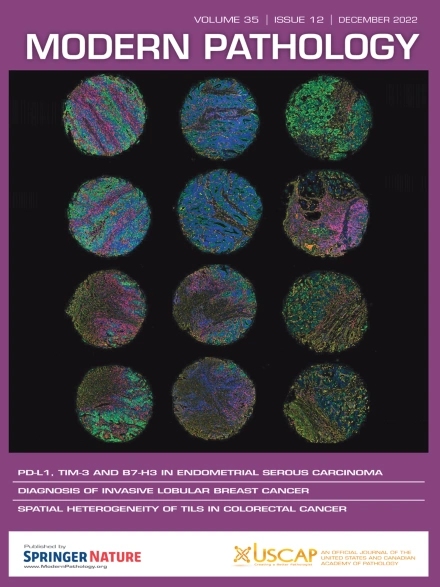轴外低分化脊索瘤:临床病理学和分子遗传学特征。
IF 7.1
1区 医学
Q1 PATHOLOGY
引用次数: 0
摘要
分化不良脊索瘤(PDC)是脊索瘤的一种侵袭性亚型,其特点是SMARCB1(INI1)缺失和预后不良。它通常累及轴性骨骼,最常见的是颅底和颈椎。据我们所知,目前仅有五例轴外多发性骨髓瘤(EAPDC)的报道,而且这些肿瘤的自然病史还不完全清楚。我们研究了六例轴外分化不良脊索瘤,目的是更好地了解这些异常罕见的肿瘤。这些肿瘤发生在四名女性和两名男性身上,年龄从 37 岁到 68 岁不等(中位数为 57.5 岁),肿瘤累及或起源于左膝关节(3 例)、右膝关节(2 例)和右腕(1 例)。从外观上看,所有肿瘤均为实性、分叶状,有坏死区域。组织学上,这些肿瘤与轴向分化不良脊索瘤相同,有片状和分叶状的明显恶性上皮样至横纹状细胞,核仁突出。有丝分裂活动和坏死。免疫组化结果显示,所有病例均表达角蛋白和红斑蝶呤,并缺乏SMARCB1。分子遗传分析发现,4例病例存在SMARCB1功能缺失改变,包括突变(2例)和拷贝数丢失(2例)。对4例轴外分化不良脊索瘤进行的DNA甲基化分析表明,这些病例与轴性PDC聚集在一起。临床随访(6例患者;中位11.5个月;1-26个月)显示,4例患者接受了经股截肢手术,1例接受了关节外切除术。没有人接受新辅助放疗;1人接受了新辅助化疗,1人接受了辅助化疗/免疫治疗。2 名患者在术后 7 个月和 8 个月出现局部复发;3 名患者在术后 7-11 个月出现转移。2 名患者在转移性疾病发生后存活(7 个月和 13 个月),1 名患者因病死亡(20 个月),3 名患者无病(1-26 个月)。我们的结论是,轴外分化不良脊索瘤是一种侵袭性恶性肿瘤,异常偏爱膝关节,发病机制不明。本文章由计算机程序翻译,如有差异,请以英文原文为准。
Extraaxial Poorly Differentiated Chordoma: Clinicopathologic and Molecular Genetic Characterization
Poorly differentiated chordoma (PDC) is an aggressive subtype of chordoma characterized by SMARCB1 (INI1) loss and a dismal prognosis. It typically involves the axial skeleton, most commonly the skull base and the cervical spine. To our knowledge, only 5 cases of extraaxial PDC (EAPDC) have been reported, and the natural history of these tumors is not fully understood. We studied 6 cases of EAPDC, with the goal of better understanding these exceptionally rare tumors. The tumors occurred in 4 women and 2 men, ranging from 37 to 68 years of age (median, 57.5 years) and involved or originated in the left knee joint (3 cases), right knee joint (2 cases), and right wrist (1 case). Grossly, all were solid and lobulated, with areas of necrosis. Histologically, the tumors were identical to axial PDC, with sheets and lobules of overtly malignant-appearing epithelioid-to-rhabdoid cells with prominent nucleoli. Mitotic activity and necrosis were present. By immunohistochemistry, all cases expressed keratins and brachyury and were SMARCB1 deficient. Molecular genetic analysis identified SMARCB1 loss-of-function alterations in 4 of the tested cases, including mutations (2 cases) and copy number loss (2 cases). DNA methylation profiling of 4 cases of EAPDC showed clustering with axial PDC. Clinical follow-up (6 patients; median, 11.5 months; range, 1-26 months) showed 4 patients to have received transfemoral amputation and 1 extraarticular resection. None received neoadjuvant radiotherapy; 1 received neoadjuvant chemotherapy and 1 adjuvant chemotherapy/immunotherapy. Local recurrences were seen in 2 patients at 7 and 8 months; 3 patients developed metastases 7-11 months after surgery. Two patients were alive with metastatic disease (at 7 and 13 months), 1 died of disease (20 months), and 3 were disease free (1-26 months). We conclude that EAPDC are aggressive malignancies with an unusual predilection for the knee joint and unknown pathogenesis.
求助全文
通过发布文献求助,成功后即可免费获取论文全文。
去求助
来源期刊

Modern Pathology
医学-病理学
CiteScore
14.30
自引率
2.70%
发文量
174
审稿时长
18 days
期刊介绍:
Modern Pathology, an international journal under the ownership of The United States & Canadian Academy of Pathology (USCAP), serves as an authoritative platform for publishing top-tier clinical and translational research studies in pathology.
Original manuscripts are the primary focus of Modern Pathology, complemented by impactful editorials, reviews, and practice guidelines covering all facets of precision diagnostics in human pathology. The journal's scope includes advancements in molecular diagnostics and genomic classifications of diseases, breakthroughs in immune-oncology, computational science, applied bioinformatics, and digital pathology.
 求助内容:
求助内容: 应助结果提醒方式:
应助结果提醒方式:


